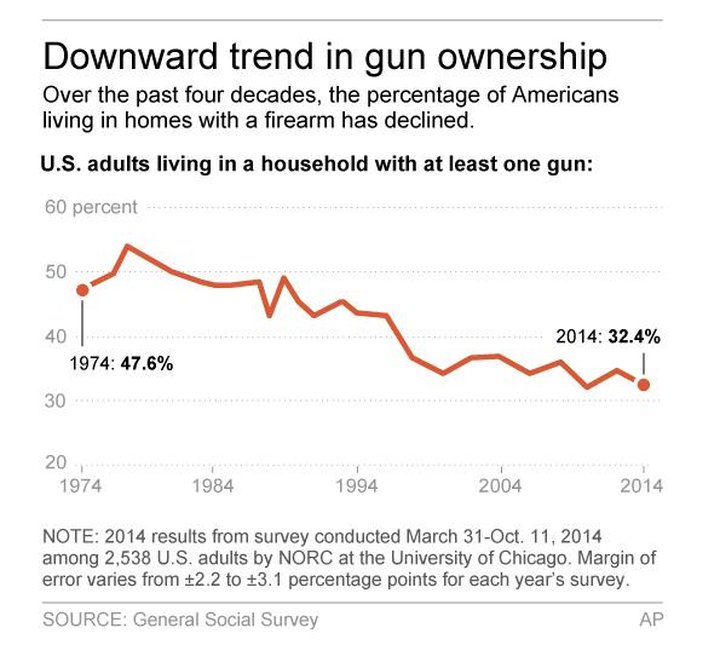Razors pain you.
Rivers are damp.
Acids stain you.
And drugs can cramp.
Guns aren’t lawful
Nooses give.
Gas smells awful.
You may as well live.
###
Trouble is, of course, that — despite what Dorothy Parker says, above — guns are lawful. Too lawful. Despite the trend towards fewer guns in homes, you’ll still find one or more firearms in about a third (maybe 40 percent, depending whose survey you believe) of households in this country.

While we hear about mass shootings, “mundane” gun deaths in homes are much more prolific. No fancy assault weapons needed; you can buy a Cobra CA380 pistol for about $100. The facts are easy enough to research, but deserve to be restated:
-
More people have died in the U.S. from guns since 1970 than have died in all the wars in the history of the country. (1.4 million vs. 1.3 million)
-
Two thirds of gun deaths in the U.S. are suicides (In 2010, the last year for which I could find statistics, guns accounted for 19,392 suicides compared with 11,078 people who were killed by others).
-
In the U.S., suicide is the 10th-leading cause of death (38,364 in 2010), with guns being used in over half these cases.
The majority of suicides can be avoided by taking away the easy access to the means including (1) bridge suicide nets or barriers; (2) individually wrapped medications; (3) the removal of carbon monoxide from household gas; (4) eliminating easy access to firearms in homes.
The first three are pretty obvious.
(1) Bridge barriers don’t lead to higher suicide rates on nearby bridges, or higher suicide rates by other means. That is, the cliché expounded by gun-control opponents, “If someone’s going to kill themselves, they’ll always figure out a way to do it” is just plain wrong. The classic study refuting the claim was published back in 1978, which showed that 94% of 505 people who had been restrained from jumping off the Golden Gate Bridge during the previous 40 years were either still alive or had died of natural causes. Convenience is as much a factor for someone thinking about suicide as anyone (—see Dorothy Parker, above).
(2) Individually wrapping analgesics and restricting the sale of barbiturates has lowered the rate of suicide by pill ingestion — citations are easy enough to find. Again, convenience matters.
(3) When I was growing up in England, the “classic” (TV and movie depictions) method of suicide was sticking ones head in the gas oven with the gas on. Blood loves carbon monoxide about 200 times more than it loves oxygen, so it doesn’t take much to cause asphyxiation. Since coal gas contains about 10% CO, suicide by gas oven was about as convenient as you could get, and in the 1960s, coal gas accounted for half the suicides in Britain. By the mid-1970s, natural gas (methane + ethane, with a terrible smell) had replaced coal gas, and the overall suicide rate dropped by a third. (The U.S. largely switched to natural gas — a by-product of oil wells — before WW2.)
(4) I’ve left the “easy access to guns in homes” to last, for obvious reasons: it’s the most contentious. “Easy access” of course is what gun owners want — if the reason for having a firearm in your home is for self-defense (the most commonly cited reason), then locking it up in a cabinet defeats the object of the exercise. (Not that the self-defense angle holds water, in any case. According to 2007-2011 numbers from the National Crime Victimization Survey, victims used a gun in only 127 of the 14,145 crimes in which “there was some degree of personal contact between the victim and perpetrator.”)
Not to belabor the point, but guns are usually lethal, while wrist cutters, car exhaust inhalers and pill swallowers often get a second chance. In their 2008 book Private Guns, Public Health, Matthew Miller and David Hemenway claim that “firearm suicides in states with the highest rates of gun ownership are 3.7 times higher for men and 7.9 times higher for women, compared with states with the lowest gun ownership — though the rates of non-firearm suicides are about the same.”

From Miller and Hemenway, New England Journal of Medicine 2008:359.
Maybe gun owners are just naturally more depressed and likely to commit suicide anyway? Unlikely. “…it’s not that gun owners are more suicidal. It’s that they’re more likely to die in the event that they become suicidal, because they are using a gun,” according to Madeline Drexler, editor of the Harvard Public Health newsletter.
###
For me, this is all like, “Duh!” When I worked the night shift on a crisis hot line, most of the callers were people in pain; they didn’t want their lives to end, they wanted their pain to end. Helping these people through a really rough patch — sometimes all it took was 30 minutes on the phone with someone who was willing to listen! — and they’ll live to fight another day. And, of course (of course to me), simply removing the means for them to kill themselves more or less on impulse gets them past the worst.
I find it tragic that otherwise smart, well-meaning people insist that a having a gun in their home keeps them safer, when the reverse is actually true.
CLICK TO MANAGE